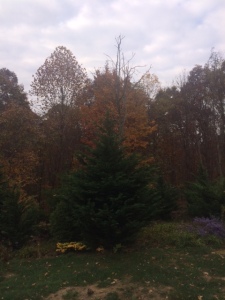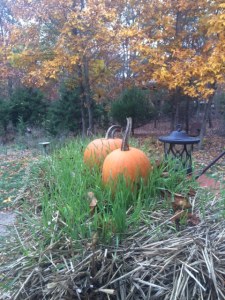“So Many Dead Lie Round”: All Hallow’s Eve
On this gloomy Halloween morning, I am led to muse on history, particularly as the celebration of all things ghoulish and frightening is upon us. Most people know that Halloween has its roots in pre-Christian rituals involving the dead and that the Church, in a process called “syncretism,” adapted and adopted many older holidays and incorporated them into the Christian calendar.
Halloween is no exception. Although most serious historians admit that there is little substantial evidence that many of the folk traditions we associate with the end of October were actually religious in their uses, popular historians have linked harvest and Halloween in pleasing ways. We like to dwell comfortably in an imagined past, where church and town co-existed harmoniously and celebrations blended different religions seamlessly.
And in some ways, such mingling did occur. Christmas trees have nothing per se to do with the birth of Jesus of Nazareth, but evergreens were long a sign that the year was at its shortest and would soon be born again. The pun-loving English, of course, immediately saw the utility of joining the “birth of the sun” to the “birth of the Son.” Easter bunnies and eggs have less to suggest about the resurrection of Christ than about the joy of new life brought by Spring.
Halloween costumes might remind us of the days of misrule once allowed by king and church, during which the disruptive forces of female power, peasant-class demands for such luxuries as food and shelter, and demonic influence were given some freedom of expression (see Michelle Brock’s blog on the Washington and Lee website for more on this). For a short time, the rules of class, patriarchy, and religious submission were relaxed, and this temporary release acted something like a valve on a pressure-cooker: letting the steam escape without destroying the meal. It’s unsurprising that Autumn, the season of greatest abundance (at least in years when the crops did not fail), was a time in which some relaxation of strict rules of right and wrong, of good and evil, might be tolerated for a while. If there was to be food, it would probably be most generously provided during the Fall of the year . . . but the knowledge of the bleak, barren winter that was icumen in also blew through the backs of people’s minds.
On November 1, hierarchies were re-established. I think here particularly of women’s roles. Some popular histories have made the same dubious historical links between contemporary movements, like Wicca, and historical events that have been made between residual folk traditions and Celtic beliefs. The real “witches,” that we celebrate on Halloween night, were mostly victims (on the Continent and in Scotland) of inquisitions fostered by the Church or (the usual case in England) of village vendettas. Women may have been able to raise their voices during celebrations of misrule, but during most of the year, they were constrained to silence and obedience. The “scold’s bridle” and the fear of being accused, tortured, and executed for witchcraft were very real. Women who seemed too skilled at healing might be thought to practice “black magic,” as opposed to the more benevolent “white magic,” which did not involve Satanic assistance . . . but the line between them often became quite blurry. The few women who actually admitted to witchcraft were few, and they were mostly deranged, afraid, or tortured into confession in hopes that their lives would be spared (they mostly weren’t).
I hold all of this in mind as I write my novels about Tudor England. My main characters believe in the immortal soul, but they reject witchcraft (as many thinking people did) and superstition. My central character, Catherine Havens, is one of those outspoken, educated women who believed both in God and in the evidence of her own eyes. Such women had to be careful. I like to imagine how they managed in a world that feared intelligent, articulate women.
I admit, I love Halloween anyway. I like the decorations and the weather. I like the food, and the cold gives me a reason to indulge, to fatten up a little for the coming winter. It’s often thought to be the day on which the veil that separates the living from the dead is thinnest, and since we will all pass through that barrier one day, human beings seem to need a way to cope with their own mortality. Halloween provides this, as a way to express the terror that our knowledge of death brings us (Stephen King once described this as the reason we like horror stories—we need to throw something to the alligators in the basements of our psyches). We embrace the skeleton that we all carry inside us. We admit that evil exists . . . and we try to let it out for a while in hopes that it will lie back down and be still for the rest of the year.
And the costumes we don often tell us something about what we fear most: our most frightening demons often appear as our politicians, or uncontrollable diseases. Or people who look different from us. We also dress up as superheroes who will save the day for us (because we can’t) or fairy-tale figures who end up happily ever after.
But November 1 comes relentlessly on, and the witches fly away. Or do they? Now, we have Salem and its spunky witches. So who and what do we demonize? And who are we hunting down, in the name of goodness? During the European witch-hunts, it might be the woman (or man) next door. A person who talked to herself. A person who spoke out against someone in power. Someone who looked strange or different. Someone afflicted with disease for which there was no cure.
Sound familiar? It all does to me. And what I am most afraid of, on this Halloween, is that the traditions passed down to us with the holiday are more wide-spread—and more invisible—than we “enlightened” descendants care to admit.





Wow that was odd. I just wrote an incredibly long comment but after I clicked submit my comment didn’t show up. Grrrr… well I’m not writing all that over again. Anyway, just wanted to say excellent blog!
Oh, I’m sorry to hear that–very frustrating, I’m sure. But thank you for the kind words; I really appreciate them!